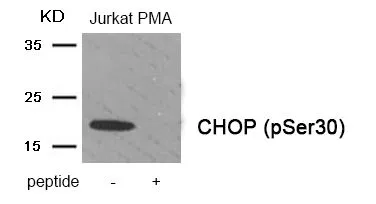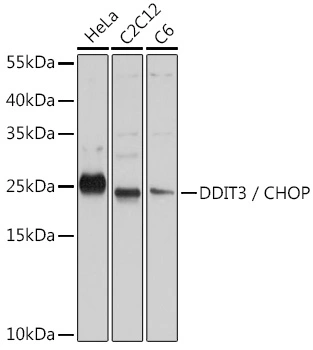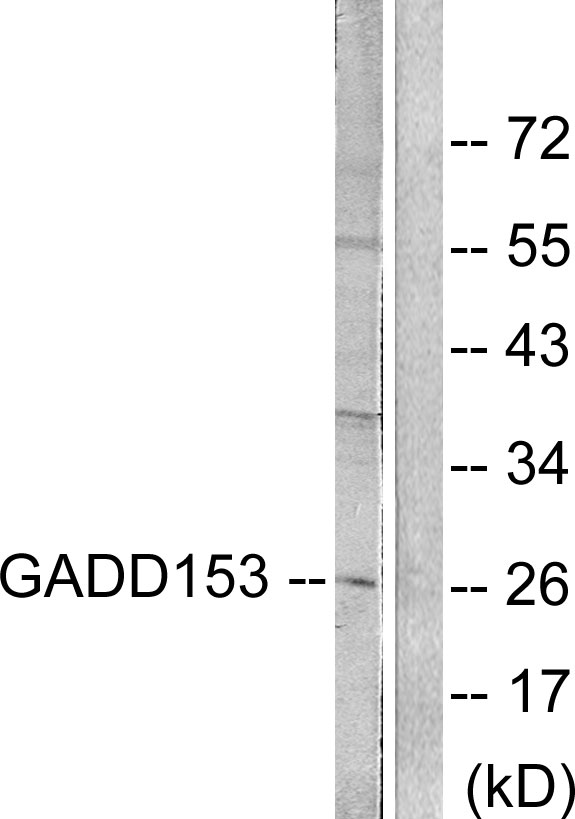GADD153 antibody [N1C3]
GTX112827
ApplicationsWestern Blot, ImmunoHistoChemistry, ImmunoHistoChemistry Paraffin
Product group Antibodies
TargetDDIT3
Overview
- SupplierGeneTex
- Product NameGADD153 antibody [N1C3]
- Delivery Days Customer9
- Application Supplier NoteWB: 1:500-1:3000. *Optimal dilutions/concentrations should be determined by the researcher.Not tested in other applications.
- ApplicationsWestern Blot, ImmunoHistoChemistry, ImmunoHistoChemistry Paraffin
- CertificationResearch Use Only
- ClonalityPolyclonal
- Concentration1.3 mg/ml
- ConjugateUnconjugated
- Gene ID1649
- Target nameDDIT3
- Target descriptionDNA damage inducible transcript 3
- Target synonymsAltDDIT3, C/EBPzeta, CEBPZ, CHOP, CHOP-10, CHOP10, GADD153, DNA damage-inducible transcript 3 protein, C/EBP zeta, CCAAT/enhancer-binding protein homologous protein, alternative DDIT3 protein, c/EBP-homologous protein 10, growth arrest and DNA damage-inducible protein GADD153
- HostRabbit
- IsotypeIgG
- Protein IDP35638
- Protein NameDNA damage-inducible transcript 3 protein
- Scientific DescriptionThis gene encodes a member of the CCAAT/enhancer-binding protein (C/EBP) family of transcription factors. The protein functions as a dominant-negative inhibitor by forming heterodimers with other C/EBP members, such as C/EBP and LAP (liver activator protein), and preventing their DNA binding activity. The protein is implicated in adipogenesis and erythropoiesis, is activated by endoplasmic reticulum stress, and promotes apoptosis. Fusion of this gene and FUS on chromosome 16 or EWSR1 on chromosome 22 induced by translocation generates chimeric proteins in myxoid liposarcomas or Ewing sarcoma. Multiple alternatively spliced transcript variants encoding two isoforms with different length have been identified. [provided by RefSeq]
- Storage Instruction-20°C or -80°C,2°C to 8°C
- UNSPSC12352203
References
- (E)-Guggulsterone Inhibits Dengue Virus Replication by Upregulating Antiviral Interferon Responses through the Induction of Heme Oxygenase-1 Expression. Chen WC et al., 2021 Apr 20, VirusesRead more
- Attenuation of Lipopolysaccharide-Induced Acute Lung Injury by Hispolon in Mice, Through Regulating the TLR4/PI3K/Akt/mTOR and Keap1/Nrf2/HO-1 Pathways, and Suppressing Oxidative Stress-Mediated ER Stress-Induced Apoptosis and Autophagy. Huang CY et al., 2020 Jun 10, NutrientsRead more
- Proteomic analysis of Antrodia Cinnamomea-induced ER stress in liver cancer cells. Chen JF et al., 2020 Aug 5, J Pharm Biomed AnalRead more
- Bilirubin disrupts calcium homeostasis in neonatal hippocampal neurons: a new pathway of neurotoxicity. Rauti R et al., 2020 Mar, Arch ToxicolRead more
- Defective endoplasmic reticulum export causes proinsulin misfolding in pancreatic beta cells. Zhu R et al., 2019 Aug 1, Mol Cell EndocrinolRead more
- Regulation of P300 and HDAC1 on endoplasmic reticulum stress in isoniazid-induced HL-7702 hepatocyte injury. Li JF et al., 2019 Feb 20, J Cell PhysiolRead more
- Endoplasmic reticulum-targeting photosensitizer Hypericin confers chemo-sensitization towards oxaliplatin through inducing pro-death autophagy. Lin S et al., 2017 Jun, Int J Biochem Cell BiolRead more
- Rosiglitazone activation of PPARgamma-dependent signaling is neuroprotective in mutant huntingtin expressing cells. Chiang MC et al., 2015 Nov 1, Exp Cell ResRead more
- The unfolded protein response is shaped by the NMD pathway. Karam R et al., 2015 May, EMBO RepRead more
- Development of a multifunctional luciferase reporters system for assessing endoplasmic reticulum-targeting photosensitive compounds. Lin S et al., 2014 Nov, Cell Stress ChaperonesRead more

![WB analysis of 30 ug of whole cell lysates from undifferentiated 3T3-L1 fibroblasts (Fib) and 3T3-L1 fibroblasts differentiated into adipocytes (Day 2 and Day 9 post-differentiation) using GTX11419 GADD153 antibody [9C8]. 3T3-L1 fibroblasts were cultured in differentiation medium for 3 days to generate adipocytes. Differentiated adipocytes were maintained in maturation media containing either 5mM glucose (normal glucose) or 30mM glucose (high glucose). Dilution : 1:1000](https://www.genetex.com/upload/website/prouct_img/normal/GTX11419/GTX11419_1466_WB_w_23060501_426.webp)




